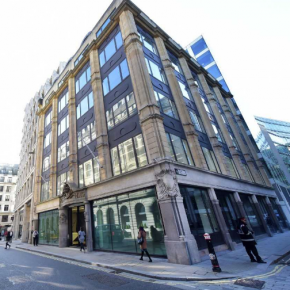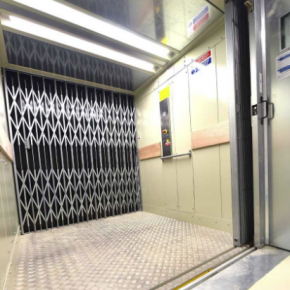
Lifts for Waste Management & Bike Transportation with Stannah
There is an increasing trend of lifts being used to aid underground storage of bikes/bins in commercial and residential projects. In this post, Stannah outline the considerations for these type of applications and the most suitable lifts to choose from.
Goods lifts are fast becoming a popular choice for Architects when planning movements within buildings and external areas, helping to enable underground bin stores in both commercial and residential projects and bike stores in residential developments.
The benefits of a bin/bike lift
For any lift the benefits are obvious – the lift platform can be virtually the same size as the load and in some applications an attendant can also travel in the lift.
Placing bike or bin storage underground helps with security and/or hiding unsightly yet necessary bins from view, offering immediate improvement in the visual environment and an increase in usable ground level space.
Some less obvious but equally important benefits of underground bins are the measurable reduction in littering and vandalism and less foul odour due to cool year-round subterranean temperatures.

All manner of goods can be transported between levels easily, safely and effortlessly – wheelie bins, 360-litre bins, Euro bins, bikes (and bike owner) can be transported vertically.
Steps and stairways need not be a problem, a split-level lift can eliminate any ramp and the large amounts of space they require, also avoiding any dangers of the bin or bike moving on it’s own.
In built-up areas and conurbations where space is at a premium, it makes sense to place bike storage areas and combined refuse areas underground.
Various sizes of bin lifts or bike lifts are available with the most popular intended to accommodate two or three residential wheelie bins and larger units being designed for apartment buildings and commercial use.
Lift considerations in such applications
Most councils provide guidelines on waste management and the requirements for collection. Specifiers should ensure that businesses and waste contractors are able to meet these requirements through the design of waste storage and collection facilities for any new developments, including storage space within the business premises.

Whilst not all Local Council guidelines state the requirements for a lift in their waste management plans, some do outline the following recommendations for larger commercial and residential applications:
– The goods lift must be large enough to accommodate a person as well as at least one waste container
– In large schemes, more than one waste container will need to be accommodated
– The lift doors and adjacent lobby or corridor must be sized so that waste containers can be easily manoeuvred
– Where lifts are provided for the use of cyclists these should be sufficiently large to accommodate their cycles i.e. at least 2m deep and preferably 2m wide with an overall door aperture of 1.2m
Lift specification for waste management
Stannah would always recommend adding the following to any bin hoist or bike lift specification:
– Bump rails – as they provide in crucial in car protection
– Stainless steel finish – typically in linen or elephant hide – providing a tough and resilient wipe clean finish
– Additional communication and safety devices if an attendant is travelling in the lift
What type of lift does Stannah recommend for these applications?
The Goodsmaster Plus (which can take up to two lift attendants) and Goodsmaster range (goods-only lifts) are the most popular in waste management due to their size and capacity options.
Whilst most regulations recommend an accompanied goods lift, it may be the preferred option to send the large waste bins unaccompanied, as there may be limited space within the car for attendants. Finally, the Levelmaster can provide a tailored solution for shorter travel requirements.
For bike lifts, where the owner accompanies the bike, Stannah would recommend its bespoke Goodsmaster HD range or a passenger lift also suitable for goods.
Sometimes a separate goods lift for larger waste management rather than sharing passenger/goods lift, is required. This could be because the bins may require a larger capacity, or that it is hygienically better to do so.
If you are interested in a goods lift for waste management and/or bike transportation, take a look at the company’s product range.
Take a look at a case study where Stannah supplied and installed a through-car goods attendant lift in commercial offices in London to move bicycles and a 1100 litre wheelie bin between the ground floor and the basement storage facility in this extensively reconfigured and refurbished building.
Looking to incorporate a lift into your project?
To enable easy specification and see if a lift can fit in your project, visit Stanna’s technical area for a wealth of product information, specifications, CAD blocks and more.
Visit Supplier's page
Latest news

28th March 2025
Ideal Heating Commercial announces 10-year warranty on Evomax 2 boiler
Evomax 2, the UK’s number one selling commercial wall-mounted boiler from Ideal Heating Commercial, is now available with a 10-year warranty.
Posted in Articles, Building Industry News, Building Products & Structures, Building Regulations & Accreditations, Building Services, Facility Management & Building Services, Heating Systems, Controls and Management, Heating, Ventilation and Air Conditioning - HVAC, Innovations & New Products, Pipes, Pipes & Fittings, Plumbing, Retrofit & Renovation, Sustainability & Energy Efficiency, Videos
28th March 2025
FLIR Si1-LD Acoustic Imaging Camera for Compressed Air Leak Detection
FLIR, a Teledyne Technologies company, introduces the Si1-LD, an industrial acoustic imaging camera that brings faster and more accurate compressed air leak detection to those operating on a modest condition monitoring budget.
Posted in Acoustics, Noise & Vibration Control, Articles, Building Industry News, Building Products & Structures, Building Services, Facility Management & Building Services, Information Technology, Innovations & New Products, Retrofit & Renovation, Sustainability & Energy Efficiency, Thermal Imaging and Monitors
28th March 2025
LIFTEX 2025 Seminar programme announced
Registration has opened for LIFTEX 2025. Now in its 37th year, LIFTEX 2025 is the UK’s only dedicated exhibition for the lift, escalator and access industry and takes place only once every three years.
Posted in Access Control & Door Entry Systems, Accessibility, Articles, Building Industry Events, Building Industry News, Building Products & Structures, Building Regulations & Accreditations, Building Services, Exhibitions and Conferences, Facility Management & Building Services, Health & Safety, Retrofit & Renovation, Security and Fire Protection, Seminars
28th March 2025
MCRMA welcomes ArcelorMittal UK to membership
A UK division of the global steelmaking business ArcelorMittal has become the latest new member of the MCRMA, the industry association representing the metal building envelope sector.
Posted in Articles, Building Associations & Institutes, Building Industry News, Building Products & Structures, Building Systems, Cladding, Facades, Posts, Restoration & Refurbishment, Retrofit & Renovation, Roofs, Steel and Structural Frames, Walls
 Sign up:
Sign up: